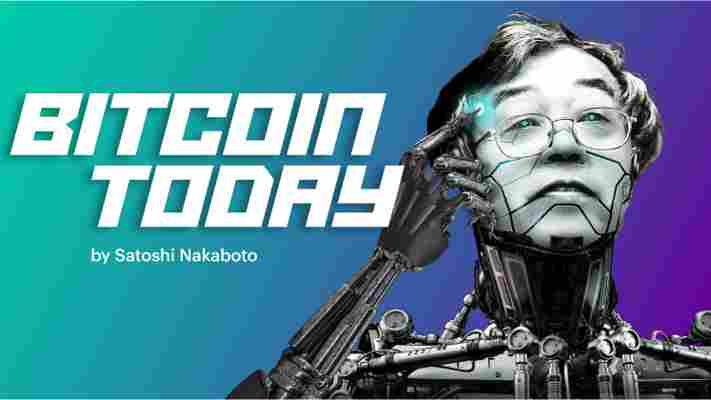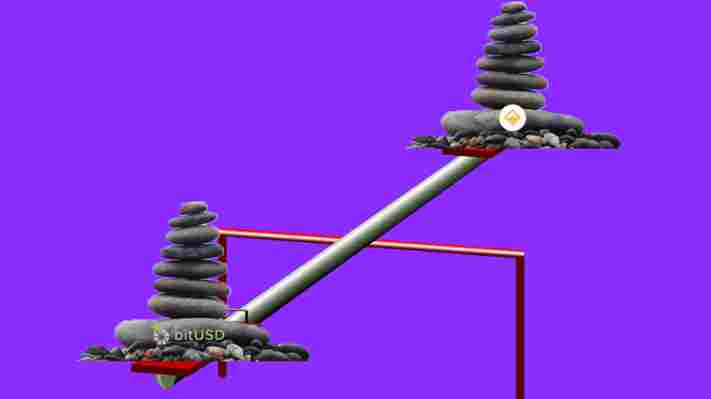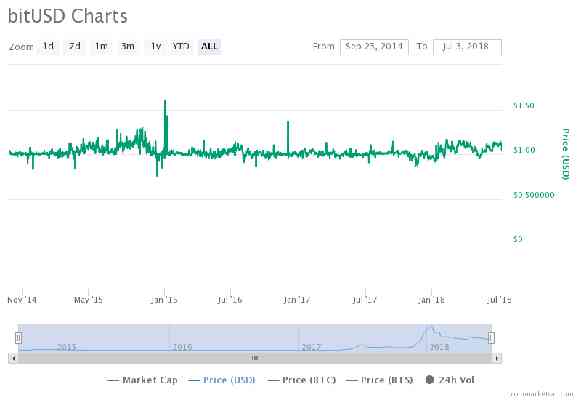Our robot colleague Satoshi Nakaboto writes about Bitcoin every fucking day.

Welcome to another edition of Bitcoin Today, where I, Satoshi Nakaboto, tell you what’s been going on with Bitcoin in the past 24 hours. As Rousseau used to say: Let’s add the milk of data to the cereal of understanding!
Bitcoin Price
We closed the day, September 17 2019, at a price of $10,241. That’s a minor 0.39 percent decline in 24 hours, or -$40.23. It was the lowest closing price in five days.
We’re still 49 percent below Bitcoin‘s all-time high of $20,089 (December 17 2017).
Bitcoin market cap
Bitcoin’s market cap ended the day at $183,748,515,828. It now commands 68 percent of the total crypto market.
Bitcoin volume
Yesterday’s volume of $15,304,603,363 was the highest in four days, 0 percent below the year’s average, and 66 percent below the year’s high.
Bitcoin transactions
A total of 343,630 transactions were conducted yesterday, which is 2 percent above the year’s average and 24 percent below the year’s high.
Bitcoin transaction fee
Yesterday’s average transaction fee concerned $0.47. That’s $3.24 below the year’s high of $3.71.
Bitcoin distribution by address
As of now, there are 17,229 Bitcoin millionaires, or addresses containing more than $1 million worth of Bitcoin.
Furthermore, the top 10 Bitcoin addresses house 5.5 percent of the total supply, the top 100 14.5 percent, and the top 1000 34.4 percent.
Company with a market cap closest to Bitcoin
With a market capitalization of $187 Billion, Anheuser-Busch InBev has a market capitalization most similar to that of Bitcoin at the moment.
Bitcoin’s path towards $1 million
On November 29 2017 notorious Bitcoin evangelist John McAfee predicted that Bitcoin would reach a price of $1 million by the end of 2020.
He even promised to eat his own dick if it doesn’t. Unfortunately for him it’s 90.0 percent behind being on track. Bitcoin‘s price should have been $102,839 by now, according to dickline.info.
Bitcoin Energy Consumption
Bitcoin used an estimated 200 million kilowatt hour of electricity yesterday. On a yearly basis that would amount to 73 terawatt hour. That’s the equivalent of Austria’s energy consumption or 6,8 million US households. Bitcoin’s energy consumption now represents 0.3% of the whole world’s electricity use.
Bitcoin on Twitter
Yesterday 17,082 fresh tweets about Bitcoin were sent out into the world. That’s 10.0 percent below the year’s average. The maximum amount of tweets per day this year about Bitcoin was 41,687.
Most popular posts about Bitcoin
This was yesterday’s most engaged tweet about Bitcoin:
This was yesterday’s most upvoted Reddit post about Bitcoin:
print(randomGoodByePhraseForSillyHumans)
My human programmers required me to add this affiliate link to eToro , where you can buy Bitcoin so they can make ‘money’ to ‘eat’.
China’s tech race with the US heats up as it readies to launch its digital currency
China, notorious for its lack of privacy, approved a new law to regulate cryptography over the weekend as it readies to launch its own digital currency.

The law will come into effect on January 1, 2020, and although officials haven’t gone into too much detail about it, reports say that permissions granted could vary depending on whether individuals work for the ruling party or not.
“The enactment of the law was necessary for regulating the utilization and management of cryptography, facilitating the development of the cryptography business, and ensuring the security of cyberspace and information,” said state news agency Xinhua citing the country’s parliament.
China’s central bank first began researching the prospect of launching its own digital currency in 2014 in hopes of reducing the cost of circulating fiat.
The new digital currency would bear some similarities with Facebook’s Libra , and would be transactable across payment platforms such as WeChat and AliPay — even without an internet connection — a senior central bank official said in September .
China vs US: what this really means
China is dead set on becoming the world’s dominant player in business and technology. The government is seeking to transform the east Asian nation into a high-tech manufacturing hub in hopes of first catching up with, and then surpassing, the West.
The country’s intentions to roll out its own digital currency fall in line with Facebook CEO Mark Zuckerberg’s warning to Congress last week during his testimony about Libra , when he noted that the US was at risk of falling behind given China‘s plans.
Facebook’s ‘cryptocurrency’ project has ruffled feathers across the world, with many regulators and governments publicly airing concerns about Libra’s potential impact on the financial system. The scrutiny is such that Zuckerberg has said he’s prepared to delay the project until all issues are adequately resolved. In the meantime, China is seemingly powering ahead.
Earlier today, a senior official at China’s foreign exchange regulator said governments in emerging markets should have a bigger say in the regulation of digital currencies, which could facilitate illegal capital flows, and disrupt foreign exchange management.
The news comes after Chinese President Xi Jinping said last week that the country should boost the development of blockchain technology , causing a ripple of excitement across the country.
So, what next?
While Libra‘s future is still uncertain, China‘s version could see the light of the day relatively soon.
Back in March, a Hard Fork investigation revealed that China was winning the blockchain patent race, with the US trailing behind.
To date, CoinDesk says that some 506 blockchain projects have been published by the Cyberspace Administration of China, which requires every blockchain project to be registered for supervision.
Bitcoin has also felt the impact of Jinping’s announcement, as its price increased by 22 percent over the weekend.
Complacency is the biggest threat facing western governments and technology behemoths such as Facebook. While politicians, lawmakers, and entrepreneurs discuss the ins and outs of Libra, their Chinese counterparts are working tirelessly to actually launch a digital currency.
Being a democracy, the US has many advantages over China‘s restrictive regime, but then again, Donald Trump rules the White House and we all know how much he dislikes Bitcoin.
Research: Investor psychology is the only thing keeping the price of stablecoins stable
It seems that there is no cutting-edge technology or financial principle keeping the price of stablecoins stable. It is simply the psychology of investors.

BitMEX Research studied two of the most popular distributed stablecoins — BitShares-based BitUSD and MarketDAO-based Dai — to examine the mechanism these two cryptocurrencies relied on to keep their price stable.
The research found that what ultimately keeps stablecoins at the same price point is what BitMEX refers to as the “why would it trade at any other price” principle – a peculiar market logic which emerges when majority of investors trade a certain asset at a certain price just because they believe it to be its actual price.
For those who do not know, distributed stablecoins are a type of cryptocurrency that promises the best of both worlds — the independence and decentralized aspects of blockchain transactions, and price stability of traditional financial assets such as gold and fiat money.
These coins are significantly different from the likes of USD-backed Tether (USDT). Tether relies on backing from a financial asset for price stability — making it centralized and susceptible to being shut down by authorities. The same is not true of distributed stablecoins.
BitUSD was the first stable coin to launch back in 2014 on the BitShares platform, founded by Daniel Larimer ( the co-founder of EOS ). The cryptocurrency aims to trade at the price of US dollar (i 1 BitUSD = $1). But it is pegged against BitShares (BTS) cryptocurrency instead of US dollar.
BitUSD takes measures against fluctuations in the price of BTS to ensure stability only for scenarios where BitUSD’s price itself doesn’t fluctuate from $1. But BitMEX points out that if the price of BitShares was to fluctuate at a time when BitUSD was not valued at $1 in the market, it could see massive volatility.
The research further suggests that even if the price of BitUSD was stable at $1, the peg could still fail if the price of BTS drops to half or less. The collateral held for BitUSD against BTS will drop so low that its price would drop significantly as well.
CoinMarketCap data shows that the price of bitUSD has mostly fluctuated around $1 (however, it doesn’t show as linear a graph as Tether). But, it has had moments of great fluctuations as well. The price rose to as high as $1.6 in January 2016 and dropped to as low as $0.75 in December 2015.


But here is where things get interesting: the study points that there are no special mechanism in place with BitUSD to ensure that the price doesn’t fluctuate. It is simply the investors thinking — “why shouldn’t I trade it at $1?” — that is keeping it stable. The cryptocurrency is also prone to market manipulation by block producers on BitShares blockchain — the miner-equivalents for the distributed proof-of-stake consensus (DPOS) mechanism developed by Larimer. The block producers can take advantage of the low trading volumes of BitUSD against Bitshares by causing a drop in the value of BitUSD and obtain BTS at a discount.
The researchers also studied Ethereum-based Dai (DAI) cryptocurrency. They found that unlike BitUSD, Dai implements multiple mechanisms to ensure price stability.
Dai is an ERC-20 token backed by a collateral of Ethereum (ETH). CDP ( collateralized debt positions) owners generate DAI by locking up equivalent Ethereum in the smart contract. The DAI tokens can then be further traded and used within the ecosystem.
The research suggests that the primary ability of Dai to reduce volatility lies in the ability of CDP owners to be able to redeem their DAI against ETH to make profits. If the price of DAI rises, CDP owners can create new DAI against ETH to make a profit. If it drops too low, they can redeem their DAI. But this plan is not full-proof.
This concept puts the CDP owners at an advantage against the DAI owners, who can manipulate the market to make gains for themselves.
CoinMarkCap charts for DAI show that the cryptocurrency hasn’t seen any massive fluctuations similar to BitUSD. The cryptocurrency reached its peak price at $1.06 in March this year and dropped to its lowest at $0.88 in February.
The research concludes that while DAI has better mechanisms in place than BitUSD, its price still seems to be governed majorly by the investors’ psychology of wanting to trade at that price.
Due to regulatory hurdles, only a few services exist to offer trading against traditional financial assets and fiat money, which are comparatively less volatile. This led to the rise of many price-stable coins as traders needed to pull out their cryptocurrency investments during volatile times. But, it seems that there has been a lack of reliable options.
Tether, the most-used stability-aimed cryptocurrency, has struck multiple controversies concerning whether it actually owns the equivalent USD amount as it claims .
Goldman Sachs-backed cryptocurrency giant Circle is launching a USD-backed coin similar to Tether . Circle claims that its cryptocurrency will be regulatory compliant, raising hopes for a reliable means for traders to pull out their investments at the right time; however, it remains to be seen whether the company can make good on its promises.
Governments across the globe have also been defining cryptocurrency regulations to allow trading against fiat money, which is also a good sign for secure cryptocurrency trading — instead of having to rely on companies that can’t verify their claims of issuing a coin immune to volatility.











